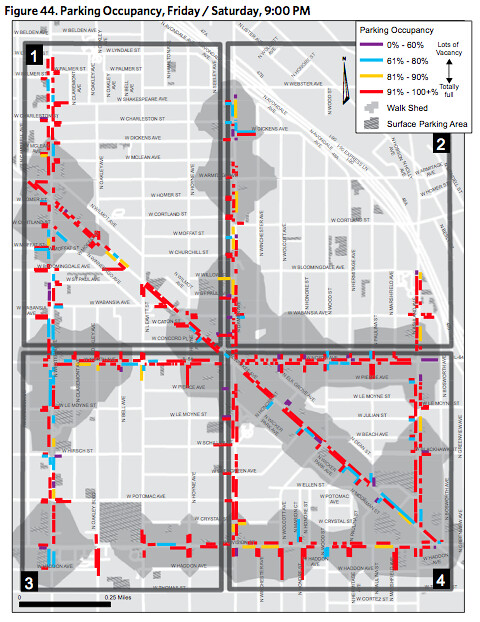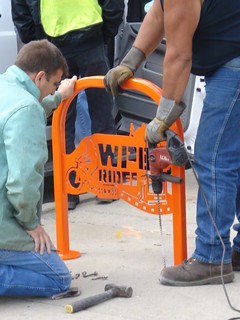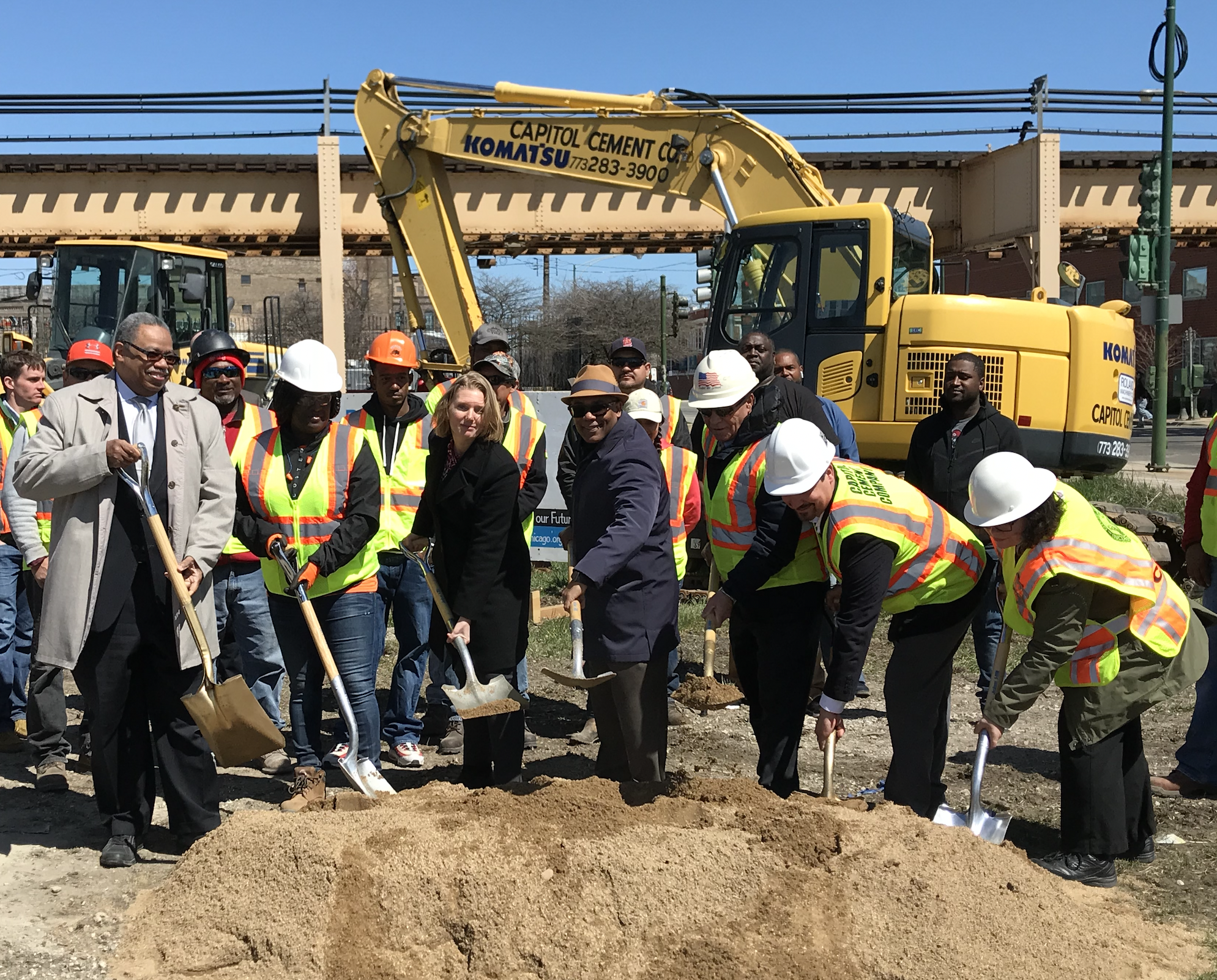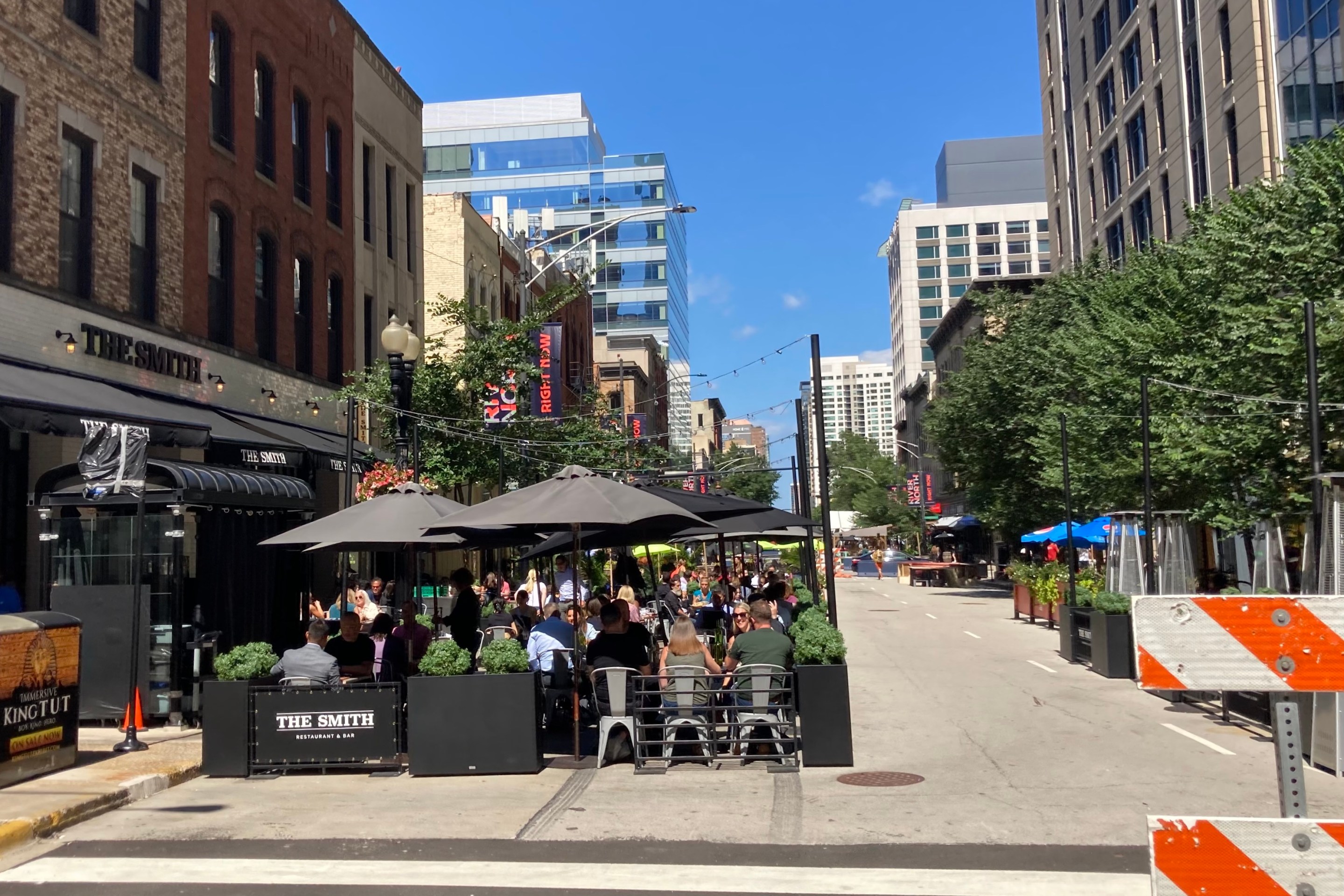Wicker Park Counts Up Better Ways to Use Its 11,650 Parking Spaces
3:22 PM CDT on July 2, 2014
Every Saturday night at dusk, the main streets in Wicker Park and Bucktown seize up. The stalled lines of cars don't just infuriate drivers -- they also stall buses, block crosswalks, and push cyclists into the dangerous door zone. These crowds don't descend out of nowhere to watch the sunset, or to pile into shows at the Double Door. No, this dangerous mess stems in large part from poorly managed public parking.
To better understand the parking situation in WPB and how to improve it, the Chicago Metropolitan Agency for Planning recently completed an Innovation in Parking Management Plan, with help from the WPB Special Service Area and the Metropolitan Planning Council. They found that WPB actually has an ample supply of parking. And that existing supply can be better managed, even under current policies like the parking meter contract.
Lindsay Bayley, who managed the project for CMAP, said that the parking plan grew out of the neighborhood's earlier planning efforts. WPB's 2009 master plan had "a lot of recommendations regarding parking. After the parking meter deal, they needed to get a handle for what was going on the ground and what they could do."
CMAP has worked on parking in suburban downtowns like Berwyn and Hinsdale, but had not yet had a chance to examine how parking management strategies might apply to city neighborhoods. Chicago has a particularly interesting situation, since the city controls much less about parking than a suburban village does -- the city operates neither garages nor meters in the neighborhoods.
WPB's long "overall support of active transportation" made it a particularly good community to study, said Bayley. "Their transportation committee is really well versed in how transportation affects the business district and how parking specifically affects it," she said. "Within the SSA, they understand that they really need a balance between walking, biking, transit, and driving" to get everyone to and through the neighborhood.
The parking plan began with an exhaustive inventory of parking supply and demand in the neighborhood, as well as public outreach through interviews, public meetings, and an online survey, that cumulatively asked roughly 500 people about transportation in the neighborhood. The resulting Parking Management Plan, recently adopted by the SSA commission, will help decision-makers better understand the neighborhood’s parking and transportation situation.
The parking inventory found that a surprising amount of parking exists within the area. The roughly one-square-mile neighborhood contains a whopping 11,650 on-street parking spaces — just 7 percent fewer than the Mall of America, the largest shopping mall in the country. Of the spaces within WPB, 73 percent are free, all of the time, and only nine percent are metered. Beth Sholtis from the SSA said she appreciates that CMAP performed a complete "inventory of the types of parking here: where the parking lots are, where the [different] zones are, where the turnover happens."
Yet there are times when even 11,650 spaces doesn’t seem like enough. CMAP sent out teams of interns to canvass the neighborhood’s street parking at different times of the week. This revealed that even though parking is readily available most of the time, there’s one key exception: weekend evenings, particularly along buzzing nightlife scenes like Milwaukee Avenue and Division Street.
Those times, as Sholtis said, are “when [many neighborhood businesses] make their money, and when traffic is the worst,” as visitors cruise the streets and hunt for available spaces. The crunch is magnified on Saturdays, especially since paid Sunday parking ended: "People can park early on Saturday night and don't have to move their car until Monday morning," said Hillary Green, communications associate at CMAP. "That's when it's impossible to find a parking space anywhere -- everyone's looking for a parking spot," agreed Bayley. One solution she suggests: "Keep the meters running later in the night, to maintain availability of spaces."

Parking availability during the day reveals different problems. "We expected to see more parking congestion on the main business streets" during the day, said Bayley, but the sharp hike in parking meter rates appear to have pushed cars elsewhere, with the result that "the main shopping streets have fairly low parking occupancy most of the time." Sholtis pointed out the flip side of this situation, which is spillover into the neighboring blocks: "Everybody knows where the free parking is, and it's gone immediately."
The few drivers who can lay claim to free parking along commercial corridors, like in business loading zones, leap at the opportunity. On Division Street, CMAP interns spent seven hours "calculat[ing] the average amount of time people stayed there. Most people stayed less than two or three hours -- but in the free spaces, the cars didn't move at all."
Thankfully for local merchants, though, their customers aren't that worried about sometimes-scarce parking. When residents, shopkeepers, and visitors were asked to describe what they enjoyed about the neighborhood, parking availability was a concern, and sometimes dissuaded shoppers from visiting the neighborhood, but it wasn't a defining characteristic of the neighborhood. Instead, maintaining the neighborhood's lively and walkable nature was a higher priority for those surveyed both in person and online.
One key strategy to maintain the area's walkability is to avoid building more off-street parking. Survey participants roundly rejected surface lots on aesthetic grounds. Moreover, they wouldn't be cost-effective given the neighborhood's high rents. New parking garages similarly don't make financial sense. Over the past few years, three different proposals for private parking garages in the neighborhood fell through once developers realized how expensive they would be. The study confirmed this, by surveying how much new parking garages in the suburbs have cost. Sholtis notes that “a garage would be utilized maybe three days a week, for maybe seven hours, and it would be the valets" rather than customers who would use it.
Instead of adding to the already plentiful supply of parking, the study urges several techniques that can better allocate existing parking -- all of which come with their own implementation challenges.
Surprisingly, the authors found that Chicago's much-reviled, privatized parking meter system has more flexibility built into it than many imagine. "We can lower rates, we can raise rates, we can put meters in different areas, we can move them around," said Bayley. "There might be flexibility to do a demand pricing program," she continued, which would help improve turnover by adjusting prices at specific times. Furthermore, 85 percent of the revenues from new meters go to the city, not to Chicago Parking Meters. Aldermen have extensive control over how metering works in their wards -- but making changes will require extensive coordination, since WPB sits in four different wards.
Many loading zones exist along WPB's commercial streets, and some businesses improperly use them as private parking spots. Instead, loading should be directed to alleys whenever possible, and curb spaces should be used for customer parking.
Existing parking lots throughout the neighborhood could be better utilized: Many are used for daytime retail shops but are empty during the evening peak hours, which Sholtis calls "a total waste of space." She points out that red tape, like zoning definitions and liability insurance requirements, can make it difficult for parking lot owners to lease their parking spaces.
In the near term, Sholtis says that the SSA will begin to better "promote the parking that's available and explain where they can park." Signs can show off hidden parking areas -- like the city parking lot on Bosworth, just east of Milwaukee and Ashland. The SSA's website and, in the future, information kiosks can "make visitors aware of where to go, and how to go," regardless of which mode brings them to WPB. Highlighting alternatives, whether through the SSA's website, its bright orange bike racks, or new taxi stands at nightlife hubs, will help to manage parking demand by visitors.
The parking management techniques identified in the WPB plan are "definitely applicable for other busy neighborhoods in Chicago, especially because of the meter situation," says Bayley. All of the plan's partners were excited to discover that Chicago can allow parking meter prices that adapt to demand, and early discussions have already started to bring about some of these innovations.
Stay in touch
Sign up for our free newsletter
More from Streetsblog Chicago
Pressure is mounting to replace embattled CTA President Dorval Carter
Here's a look at what elected officials and other media outlets have said about the issue recently.
Service boost means BNSF Line will get Metra’s first-ever across-the-board weekend schedule, starting April 29
In addition, Halsted Street station will get weekend service, and Downers Grove's Fairview stop will become an off-peak stop.
Tasty news: Friedman Properties is trying to break the Clark outdoor dining stalemate by applying for street closure permits
Mayor Johnson's administration and Ald. Reilly haven't yet found common ground on bringing back the popular car-free zone. Will this make the difference?






